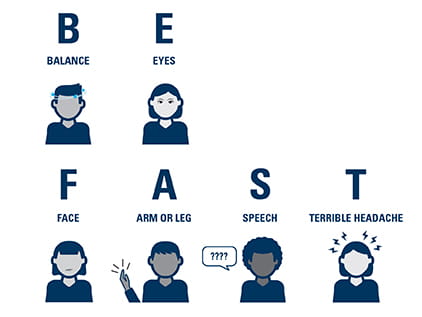March 25, 2020
Greg Batson was in Kansas City, Missouri, on routine business. Usually, he would have driven home to Webb City, Missouri, at the end of his shift, but with a snowstorm in the forecast, he decided to stay in the city overnight. It was December 16, 2019.
As he walked downtown, Greg called his wife, Tammy. As the couple talked, Greg, 51, began breathing heavily, and his speech became slurred. Tammy grew concerned. Having been a 911 dispatcher for 15 years, she knew the signs of a stroke.
Calling 911
"Where are you?" Tammy asked her husband, trying to home in on his exact location so she could call paramedics.
Greg's response was unintelligible.
Their teenage daughter, Hannah, grabbed her smartphone and used the Life360 app to locate her father. He was at West 12th Street and Broadway Boulevard. And, unbeknownst to Tammy and Hannah, he was lying in the snow.
"I didn't suspect anything was wrong," Greg says, remembering that evening. "I thought I was talking normally. When I fell, I thought I had slipped on the snow. I had a bottle of Gatorade in my left hand. I kept dropping it."
Hannah called Jasper County Emergency Services. The dispatcher put Tammy in touch with the Kansas City, Missouri, Fire Department's dispatch center, which sent an ambulance to Greg's location.
In the meantime, 2 strangers had stopped to help Greg. One of them relayed Greg's condition to Tammy on the phone. When the ambulance arrived, the stranger handed Greg's phone to paramedic Tyler Winfrey. Tammy told Winfrey that Greg had a significant heart condition, but she believed he was having a stroke.

BE FAST: Know the signs of stroke
- Balance: Imbalance, headache, dizziness?
- Eyes: Is vision in 1 or both eyes difficult?
- Face: Does 1 side of the face droop or is it numb?
- Arms: Is 1 arm or leg weak or numb?
- Speech: Is speech unclear or slurred?
- Terrible headache: Did the headache come on within seconds or minutes? Is it one of the worst headaches the person has experienced? If the headache meets these criteria and is accompanied by other symptoms listed above, it may be a sign of stroke. T is also for time. Call 911 right away if someone is exhibiting signs of stroke.
Time is brain
Confirming the symptoms, the EMS team transported Greg to The University of Kansas Health System's Advanced Comprehensive Stroke Center. While en route, Winfrey communicated Greg's symptoms, the onset time and his medical history to the emergency department physicians and the health system's acute stroke response team (ASRT).
"The EMTs and paramedics are the first responders outside the hospital," says attending neurologist Yunxia Wang, MD. "The ASRT is the first responder inside the hospital. We are uniquely equipped to emergently evaluate and treat stroke patients."
Because of Winfrey's detailed and accurate information about Greg's condition, the response team immediately took Greg to a CT scanner, saving precious time.
"Time is brain," Dr. Wang says. "Stroke patients have a much greater chance of surviving and avoiding long-term brain damage if they arrive at a specially qualified hospital and receive advanced treatment within an hour of onset."
While Greg was in the CT scanner, a care team including physicians and nurses prepared to administer the clot-busting drug that is the standard of care for patients within the critical time window in which it is effective. The team also reviewed Greg's medical history to confirm that he did not have preexisting conditions that would prevent him from receiving this medication.
The CT scan confirmed the team’sclinical diagnosis: Greg was having an ischemic stroke caused by a blood clot restricting blood flow to his brain. He received tPA just 15 minutes after arrival to the hospital.
The swiftness with which the ASRT treats stroke patients has earned the health system the American Heart Association’s Target Stroke℠ Honor Roll "Elite Plus" designation year after year since inception of the award.
The health system was also among the first 5 in the nation to receive designation as a Comprehensive Stroke Center from The Joint Commission. The distinction means specially trained physicians are available to perform a thrombectomy, a procedure to remove the blood clot that is causing a stroke.
From door to device in 65 minutes
Dr. Wang also notified the interventional radiology team.
"In stroke care, the interventional radiology team is the second responder inside the hospital," she says.
Greg needed a thrombectomy to fully restore blood to his brain. The CT results showed a large blood clot in the right temporal and right frontal portion of the brain, indicated by the loss of control of the left side of the body.
The response team transferred Greg to the interventional radiology suite, where a team specializing in endovascular thrombectomies was waiting for him. Using guided imagery, neurointerventionalist Michael Abraham, MD, navigated a narrow catheter through an artery in Greg's groin to his brain and sucked out the clot through the catheter in a single pass.
"In earlier days, trying to remove a clot could take 45 minutes to an hour," Dr. Abraham says. "With these newer devices, we have accelerated the process significantly."
The timeframe from accessing the artery in Greg's leg to completely opening the blood vessel was 15 minutes.
"Greg's blood flow was restored 65 minutes after he arrived," Dr. Abraham says. "For the best possible patient outcomes, our goal is 90 minutes. For Greg, we were able to beat that time considerably."
Full recovery
Just 90 minutes after Greg's first call to Tammy, as she was on her way to Kansas City, her phone rang again. Caller ID showed her the call was coming from Greg's phone. She answered.
"Hey, whatcha doin’?" Greg said.
This time, Tammy understood every word. Greg had recovered from surgery and was speaking clearly. He left the hospital on December 18, 2019, less than 48 hours after his stroke began, and returned to work less than 2 weeks later.
"Coming to a Comprehensive Stroke Center provides patients the best chance for survival,” says ICU unit educator Hannah Pepper, RN, who contributed to Greg's care. “The members of our acute stroke response team are specifically trained to work together to quickly, efficiently assess and treat patients. Seeing Greg leave our hospital with an amazing outcome is the driving motivation behind what we do."
Greg and Tammy are thankful for the care he received at the health system, and for the people who provided it.
"My care team was quick, efficient, very knowledgeable and very precise," Greg says.
"The overall care was just wonderful," Tammy adds. "I highly recommend this hospital."
Dr. Wang praises Tammy's actions in supporting Greg, too.
"If you are experiencing a stroke, call 911 like Tammy did”," she says. “First responders can activate our response team for better outcomes just as they did for Greg."
Mystery men
The Batsons have thanked the response team, the KCFD EMTs and paramedics and both dispatchers, but the good Samaritans who came to Greg's aid as they found him lying on the sidewalk remain a mystery.
"We wish we knew who they were," Tammy says. "We would love to thank them."

Do you know your numbers?
Patient testimonial: As with all treatments, individual patient results vary. It is important to discuss your treatment options with your healthcare provider.





